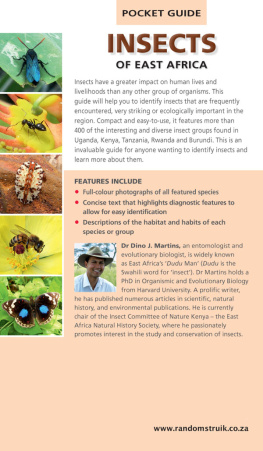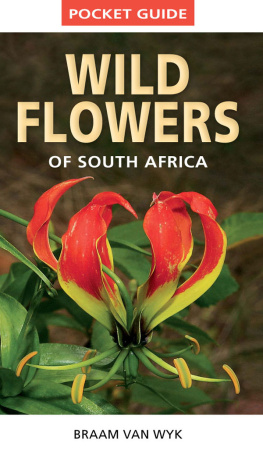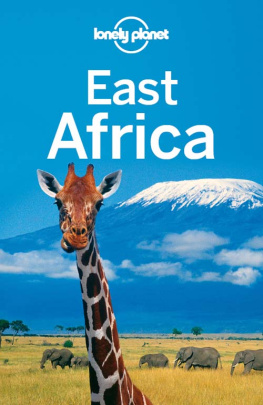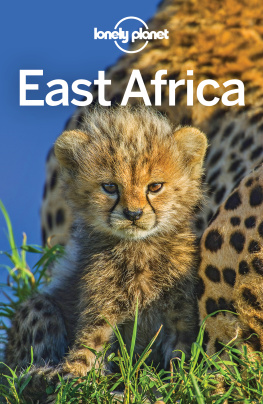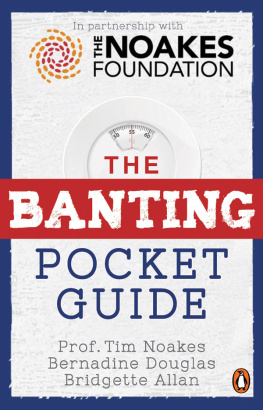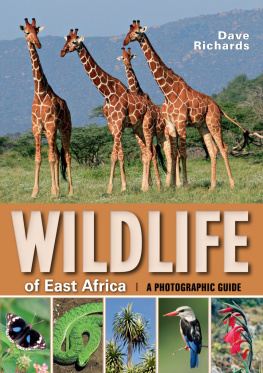Dino J. Martins - Pocket Guide Insects of East Africa
Here you can read online Dino J. Martins - Pocket Guide Insects of East Africa full text of the book (entire story) in english for free. Download pdf and epub, get meaning, cover and reviews about this ebook. year: 2015, publisher: Penguin Random House South Africa, genre: Home and family. Description of the work, (preface) as well as reviews are available. Best literature library LitArk.com created for fans of good reading and offers a wide selection of genres:
Romance novel
Science fiction
Adventure
Detective
Science
History
Home and family
Prose
Art
Politics
Computer
Non-fiction
Religion
Business
Children
Humor
Choose a favorite category and find really read worthwhile books. Enjoy immersion in the world of imagination, feel the emotions of the characters or learn something new for yourself, make an fascinating discovery.
- Book:Pocket Guide Insects of East Africa
- Author:
- Publisher:Penguin Random House South Africa
- Genre:
- Year:2015
- Rating:3 / 5
- Favourites:Add to favourites
- Your mark:
- 60
- 1
- 2
- 3
- 4
- 5
Pocket Guide Insects of East Africa: summary, description and annotation
We offer to read an annotation, description, summary or preface (depends on what the author of the book "Pocket Guide Insects of East Africa" wrote himself). If you haven't found the necessary information about the book — write in the comments, we will try to find it.
Pocket Guide Insects of East Africa — read online for free the complete book (whole text) full work
Below is the text of the book, divided by pages. System saving the place of the last page read, allows you to conveniently read the book "Pocket Guide Insects of East Africa" online for free, without having to search again every time where you left off. Put a bookmark, and you can go to the page where you finished reading at any time.
Font size:
Interval:
Bookmark:

Published by Struik Nature
(an imprint of Random House Struik (Pty) Ltd)
Reg. No. 1966/003153/07
The Estuaries No. 4, Oxbow Crescent, Century Avenue, Century City, 7441
PO Box 1144, Cape Town, 8000 South Africa
www.randomstruik.co.za
First published in 2014
1 3 5 7 9 10 8 6 4 2
Copyright in text, 2015: Dino Martins
Copyright in photographs, 2015: Dino Martins (unless otherwise indicated alongside image)
Copyright in maps, 2015: Chris and Mathilde Stuart
Copyright in published edition, 2015: Random House Struik (Pty) Ltd
Publishing manager: Pippa Parker
Managing editor: Helen de Villiers
Editor: Emily Bowles
Designer: Gillian Black
Reproduction by Hirt & Carter Cape (Pty) Ltd
Printed and bound by Toppan Leefung Packaging and Printing (Dongguan) Co., Ltd, China
All rights reserved. No part of this publication may be reproduced, stored in a retrieval system or transmitted, in any form or by any means, electronic, mechanical, photocopying, recording or otherwise, without the prior written permission of the copyright owner(s).
ISBN 978 1 77007 894 9. E-PUB 978 1 77584 272 9. E-PDF 978 1 77584 273 6.
photograph: Green tachinid fly
photographs (top to bottom): Burnet moth, black sugar ant, water penny (F. Smith), honeybee and dark blue pansy (M.N. Mutiso)
photograph: Picasso bugs
photograph: Praying mantis
This book is inspired by and dedicated to the many young naturalists, students and communities that I have had the pleasure of training and working with in East Africa. I have been able to develop my work on insects through collaboration and support from many different institutions over the years including Nature Kenya, the National Museums of Kenya, the Turkana Basin Institute, the Museum of Comparative Zoology at Harvard University, the Kenya Horticultural Society, the Mpala Research Centre, the Kenya Agricultural Research Institute, the Kenya Wildlife Society, the Pest Control Products Board, the Suyian Trust, the National Geographic Society and the Food and Agricultural Organisation of the United Nations (FAO).
Information, insights, support, and collaboration in many different forms have been provided by: A. Powys, G. Powys, L. Coverdale, D. Roberts, N. Pierce, D. Haig, A. Pringle, F. Jenkins, W. Tong, J. Kingdon, L. Snook, D. Estes, E.O. Wilson, K. Horton, R. Leakey, M. Leakey, L. Leakey, G. Domberger, D. Wallis, E. Whitley, A. Whitley, I. Angelei, P. Kahumbu, S. Kahumbu, B. Gemmill-Herren, H. Herren, S. Miller, T. Kuklenski-Miller, R. Copeland, W. Kinuthia, L. Njoroge, C. Hemp, I. Gordon, M. Kasina, S. Kocher, M. Kinnaird, J. Mamlin, S.E. Mamlin, N. Croze, E. Krystall, V. Otieno, P. Matiku, D. Kathurima, F. Ngweno, M. Gikungu, T. Griswold, L. Packer, B. Danforth, C. Eardley, M. Kulhmann, J. Ascher, N. Azzu, P. Lomosingo, B. Obanda, T. Achevi, W. Okeka, W. Tiren, J. Wakhungu, J. Margaret, C. Zook, J. Sandhu, P.D. Paterson, and many, many others. I am especially thankful to M.N. Mutiso, E.M. Gitonga, A. Powys and F. Smith for the use of their photos.
I am very grateful for the support from Random House Struik, and especially Pippa Parker, for taking on this project and publishing this work on East African insects.

Over 1 million species of insect have been described; this truly is one of the most wonderful, interesting and diverse groups of creatures on our planet. These amazing organisms can be found almost everywhere in East Africa, from the snow-capped peaks of mounts Kenya and Kilimanjaro to the hottest, driest deserts and in every imaginable habitat in between. Insects live in the soil, inside both dead and living wood, in water, on every possible plant part and even on or in the bodies of animals (including humans!).
There is no other group of organisms that has such an immense daily impact on human lives and livelihoods. Insects are essential for the functioning of virtually all East African ecosystems: they play a vital role in recycling nutrients and energy, breaking down biomass, building and aerating soil, dispersing seeds and pollinating plants. For example, over 80 per cent of all flowering plants depend on insects for pollination. Without bees and other insect pollinators there would be no mangoes, avocados, guavas, apples, pears, plums, papaya, passion fruit, cowpeas or cocoa (chocolate) and far less coffee would be available in East Africa! In just one area of Kenya alone (Baringo County), bee pollination of watermelons is worth over $10 million per year. It is estimated that we owe one in three bites of food to the services of pollinators, mainly insects.
Insects are also responsible for much damage to crops. Locusts, armyworms, aphids, whiteflies and many other pest species take a toll on crops across East Africa. Maize weevils, and other insects that feed on stored grains, impose a heavy tax on our harvests by eating four out of every 10 bags harvested. However, one of the best ways of controlling pests is by encouraging their natural predators and parasites, and many insects themselves feed voraciously on insect pest species, providing efficient natural pest control.
Insects are also important vectors of disease in East Africa, with various species of mosquito transmitting malaria, lymphatic filariasis (elephantiasis) and yellow fever (now very rare), and tsetse flies transmitting sleeping sickness to humans and nagana (trypanosomiasis) to livestock. Other insect parasites include jiggers (a kind of flea), which cause much suffering, especially among children in rural areas. The infamous Nairobi Eye (caused by a species of rove beetle) erupts seasonally and plagues people across East Africa with severe, painful blisters.
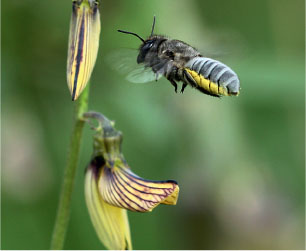
A leafcutter bee approaches a flowering pigeon pea insects are among the most important wild pollinators.
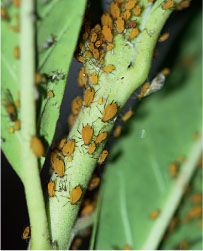
Milkweed aphids clustered on Gomphocarpus stenophylla
Many insects are exploited for food in East Africa, including termites and various grasshoppers and locusts, which are considered a delicacy in some areas. Beautiful butterflies are reared for export and display in live butterfly houses by a number of rural communities in East Africa, providing an essential source of income and an impetus to conserve forest habitats.
This book is meant to serve as an introduction to the amazing insect diversity of East Africa. With just over 400 species described, this is just a drop in the ocean of insect diversity, but hopefully it will inspire more interest, awareness and appreciation of these fascinating, strange and wonderful creatures.
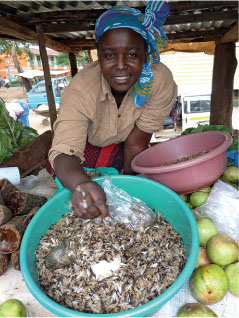
Delicious termite alates for sale in the market at Kakamega Town, Western Kenya
Insects are grouped together in the class Insecta. They have existed on the earth for many hundreds of millions of years. Insects are part of the phylum Arthropoda (animals with jointed limbs and segmented bodies), which includes the millipedes, spiders, scorpions and others. Insects are thought to have diversified and co-evolved together with the majority of flowering plants (angiosperms). Evolutionary studies of insects indicate that they have ruled the planet for a long time; therefore, we are actually living in the Age of Insects!
Font size:
Interval:
Bookmark:
Similar books «Pocket Guide Insects of East Africa»
Look at similar books to Pocket Guide Insects of East Africa. We have selected literature similar in name and meaning in the hope of providing readers with more options to find new, interesting, not yet read works.
Discussion, reviews of the book Pocket Guide Insects of East Africa and just readers' own opinions. Leave your comments, write what you think about the work, its meaning or the main characters. Specify what exactly you liked and what you didn't like, and why you think so.

